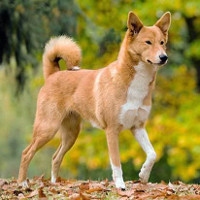Appearance of the Sibercaan
|
| The Sibercaan is a medium-sized working dog that is generally square in shape, although some can be a little longer than they are tall. They have a balanced head, somewhat flat and broad between the ears, and generally inherit the almond-shaped eyes that are characteristic of all three breeds, although their eyes can be any color, including browns ranging from almost black to amber, hazel eyes, blue eyes and even particolored eyes, depending on their overall ancestral makeup. Their muzzle is of medium length and somewhat pointed, their small to medium-sized triangular ears are pricked near the top of their skull, and they have the thick, dense coat common to almost all Spitz-type breeds. While the coat of the Canaan Dog is relatively short, that of the Siberian Husky is a little longer, so the Sibercaan's coat can be short to medium in length, and it can sport a solid-colored coat or a predominantly white coat with Siberian Husky-like markings or large patches of color, as sometimes seen in the Canaan Dog. Dogs that are mixed with the Native American Indian Dog instead of the Siberian Husky can sometimes have a longer coat and can add the possibility of a spotted, tortoiseshell-colored coat, as well as the occasional possibility of being considerably larger than the usual Sibercaan. |
Temperament of the Sibercaan
|
| This is an active, intelligent hybrid that is likely to inherit an extremely high activity level from the Siberian Husky or Native American Indian Dog and an extremely alert, trainable nature from the Canaan Dog, although consistency and gentle reinforcement are necessary as heavy-handed methods can result in a stubborn, wilful response, and repetitive methods will result in a bored dog that may decide to try and train you instead. Although interactions between children and dogs should always be closely supervised, the three possible parent breeds tend to be very loyal to their families and are quite good with older children and quite tolerant of younger children too. They should not be left alone for long, as these sociable dogs quickly succumb to separation anxiety or depression and can become obsessively noisy or destructive. While the Siberian Husky and Native American Indian Dog are also quite friendly with strangers, other dogs and even other animals, the addition of the Canaan breed increases prey drive and aggression towards other dogs and can also increase suspicious behavior towards strangers. These dogs are totally unsuited to apartment living due to their high energy, vocal nature and aversion to confinement, and are more likely than other dogs to resist crate training. |
Needs and activities of the Sibercaan
|
| The Sibercaan is an extremely athletic, active dog that needs plenty of exercise to stay in top shape. At least an hour to an hour and a half of vigorous activity is needed every day to keep this dog stable and healthy, although most enjoy even more exercise. The Sibercaan is also an extremely intelligent crossbreed, and combining mental exercise with physical activity is highly recommended. Activities for the Sibercaan that can combine mental exercise with physical activity can include agility training, advanced obedience, dog sledding, tracking exercises and sometimes even herding activities, although these dogs don't often enjoy water sports. |
Maintenance of the Sibercaan
|
| Grooming this dog generally requires a moderate amount of work, although longer coats require more time and effort than shorter ones. Bathing is only necessary once or twice a year, but it's particularly important to ensure that the undercoat is completely dry in these dogs, as persistent dampness can lead to mold formation near the skin. The Canaan Dog and Native American Indian Dog shed very little hair for most of the year, and only need brushing two or three times a week to prevent knots and matting, and to distribute the dog's natural body oils correctly. The Siberian Husky, on the other hand, sheds a lot throughout the year and requires daily brushing all year round to control constant hair loss. |









 English (United Kingdom)
English (United Kingdom)